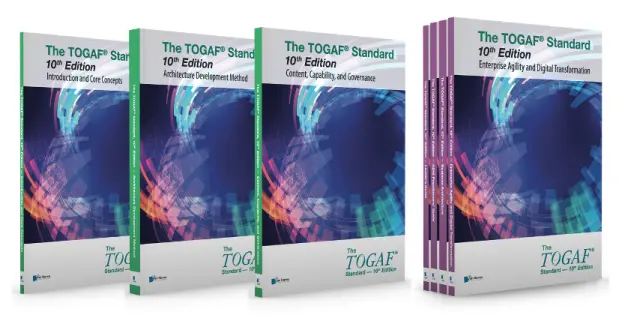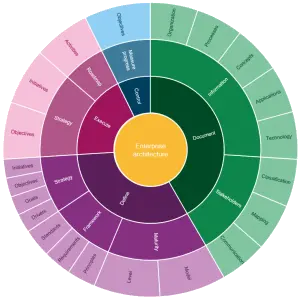We are probably all familiar with the TOGAF® Standard. Or just TOGAF, for friends and foes. An Enterprise Architecture framework pur sang and a very complete one if you ask me. The framework covers all aspects of Enterprise Architecture and allows for all kinds of tailoring. This makes it an excellent framework for any architecture implementation. In other words, the TOGAF Standard is awesome!
The why
The framework owes its awesomeness to the following reasons:
- It’s been around for decades and is still continuously evolving
- It covers all aspects of Enterprise Architecture, most certainly not just the IT part
- It has an actual and highly adaptable process for applying and implementing Enterprise Architecture
- It encourages its users to tailor it to fit the needs of the architectural challenges
I will elaborate on the reasons above.
The when
Before diving into the reasons I just gave for dubbing the TOGAF Standard an awesome Enterprise Architecture framework, let’s go back to the origins of the framework. For this, we need to go all the way back to 1995. This is the year in which the TOGAF Standard was created by The Open Group. It was a further development of TAFIM (Technical Architecture Framework for Information Management). Nowadays, the TOGAF Standard is one of the best-known architecture frameworks, along with the Zachman Framework™. The TOGAF Standard consists of several components. These include an Architecture Development Method (ADM), a set of standards, and a set of tools and techniques. The TOGAF Standard is designed to help organizations develop a holistic and integrated Enterprise Architecture that is aligned with their business objectives.
Throughout the past decades, the TOGAF Standard has been – and still is – widely used by large organizations and government agencies. The framework provides a structured approach to developing and implementing Enterprise Architecture. It also provides a common language and method for communicating architecture concepts and solutions.
One of the many key benefits of the TOGAF Standard is its wide acceptance and popularity within the industry. The framework is used by thousands of organizations around the world. This has led to the development of an extensive ecosystem of tools, training, and certification programs.
The 10th Edition of the framework was released on April 25, 2022.

The what
It is often said that the TOGAF Standard is an IT architecture framework par excellence. Therefore, it would not be useful as an Enterprise Architecture framework. However, nothing could be further from the truth. Over several decades, the TOGAF Standard has become increasingly focused on Enterprise Architecture. Partly due to the introduction of improved support for business and IT alignment, the framework has evolved into a full-fledged Enterprise Architecture framework. The introduction of the 10th Edition brought with it a strong focus on Business Architecture. It is important to note that the Open Group now relies heavily on the Business Architecture Guild’s approach to Business Architecture (see their BIZBOK Guide for more information).
Architects who still believe that the TOGAF framework is exclusively an IT framework are, in the vast majority of cases, relying on earlier (and now obsolete) versions of the TOGAF Standard. I encounter this type of architect on a regular basis. When I ask them when the last time was that they were actually exposed to TOGAF, or actively used (parts of) the framework, nine times out of ten they say it was ten to twenty years ago. The world around us has changed quite a bit in those ten to twenty years, and so has the TOGAF Standard. It is no longer the IT framework it started out as in the mid-1990s.
The how
The Architecture Development Method (ADM) is a key component of the TOGAF Standard; it is at the heart of it all. The ADM is a comprehensive and iterative approach for developing and managing Enterprise Architectures. The ADM provides a step-by-step guide for creating and maintaining architecture artifacts and ensuring alignment with business goals. It includes several phases, including identifying business needs, developing an architecture vision, creating an architecture plan, implementing the architecture, and keeping the architecture up to date.
The ADM is considered a process that enables Enterprise Architects to develop and implement Enterprise Architecture. Actually, the TOGAF Standard is one of the few architecture frameworks that includes a process description for developing Enterprise Architecture.
It is important not to infer statements from the TOGAF framework that are not present. The TOGAF ADM does not:
- Mandate that the steps must be performed in the sequence shown
- Mandate a “waterfall” process; i.e., that each phase must complete before the next begins
- Specify the duration of any phase or cycle of architecture development
The TOGAF framework does recommend that the ADM be adapted to meet the needs of the enterprise; agility is one such need.1
The flexibility of the framework is one of its strengths. Because the ADM is fully iterative, you can use it as much or as little as you like. Also, there is no need to go through all of its phases (A through H) sequentially. Architects are allowed (and encouraged) to focus on specific phases that suit their needs.
The tailorability
As mentioned above, the framework is fully adaptable to the wishes or needs of the organization in which it is used. This is necessary because there are situations where not everything described in the framework needs to be applied. Architects are therefore encouraged to use only what is necessary and useful. This tailorability is one of the strengths of the TOGAF Standard.

That not everything described in the framework has to be used is something that is often misunderstood. This is why you hear some people argue that the framework is too unwieldy or monolithic. The fact of the matter is that the TOGAF Standard does not have to be implemented from front to back. Trying to do so anyway goes against the framework’s high degree of adaptability.
I found the framework to be highly customizable when I wrote my book, Getting Started with Enterprise Architecture. In the book, I use a self-developed Enterprise Architecture Implementation Wheel. This wheel is based on the TOGAF Standard. The phases in the Implementation Wheel easily map to the phases in the ADM of the TOGAF Standard.
The simple fact that I only wanted to describe the basics of Enterprise Architecture for my book – and could easily use the TOGAF Standard – shows that the framework is perfectly suited for any kind of Enterprise Architecture implementation. Whether it is a full-blown implementation or just a basic approach, the TOGAF Standard provides the ability to apply it in a way that is suitable for any purpose.
The makeability
The framework provides a very wide range of catalogs, diagrams, and matrices that an architect can use to develop and visualize architecture. Each of the architectural deliverables or artifacts presented in the framework is well thought out and tightly aligned with the surrounding architectural concepts.
The TOGAF framework also integrates easily with the globally accepted (and initially developed independently of TOGAF) ArchiMate modeling language. Following its acquisition by The Open Group in 2008, this modeling language has been further developed. This has ensured continued integration between the framework and the modeling language.
The conclusion
The TOGAF Standard is a highly flexible and easily adaptable framework. It allows architects to apply the wealth of written information and guidance in any form, depending on the situation or stage of maturity an organization finds itself in. It is also one of the few frameworks that provides an actual process that can be followed to implement an architecture. This process is as adaptable as the rest of the framework, by which I refer to the iterative nature of the process. The ADM also offers more than excellent applicability in Agile environments.
TOGAF obviously stands for The Open Group Architecture Framework, but I would like to dub it: The Open Group’s Awesome Framework.







Leave a Reply